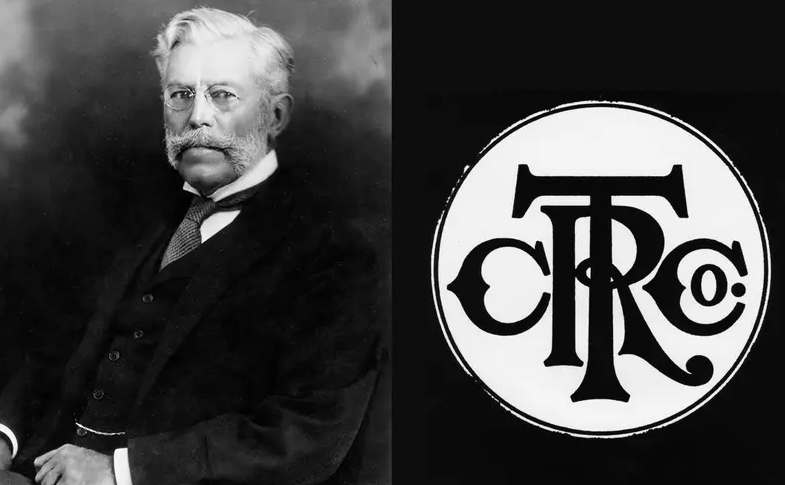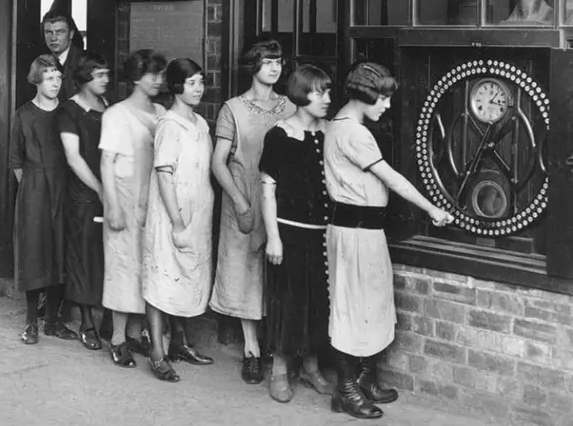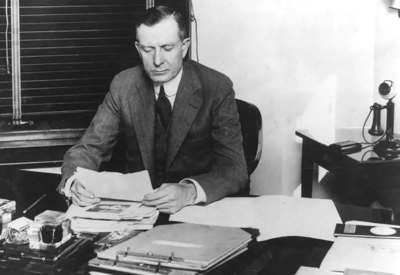| 100 Years Ago, Enter IBM |
| Written by Sue Gee | |||
| Friday, 16 February 2024 | |||
|
February 15, 1924 was the day on which the Computing-Tabulating-Recording Co was renamed as International Business Machines. It was just two days before the 50th birthday of Thomas J Watson Senior, making 17 February 2024 the 150th anniversary of the birth of the man known as the Father of IBM.
As its clunky name suggests, the Computing-Tabulating-Recording Co was made up of three separate companies. The first was the International Time Recording Co founded in 1900 by Charles Flint which soon became known as the goto company for time-recording products in the United States and Canada. Workers punch in and out on a dial recorder from the A year later Flint acquired the Computing Scale Co., which made tabletop scales together with cheese slicers and office furniture and in 1911 he added the Herman Hollerith’s Tabulating Machine Co, founded after Hollerith’s success with data processing the 1890 Census using punch card technology. Initially there was no co-ordination between the three companies with regard either to personnel or assets but things changed when Flint persuaded his board of directors to hire a professional manager. This role went, in 1914 to Thomas J Watson who was 40 at the time and had had a somewhat chequered career. From a family of Scottish decent who had emigrated from Ireland to avoid the potato famine and after completing accounting and business courses, Watson went on the road selling sewing machines and pianos with a traveling salesman. The company where he learned his commercial and managerial skills, however, was NCR – National Cash Registers. Initially he failed to sell any cash registers but under the tutelage of a talkative Irish salesman-cum-manager called John Range became the top salesman in the area. His next move was to be manager of his own branch. Near the bottom of the NCR sales league when Watson took it over, within a few months his branch was sixth from the top. Then sales fell off, partly due to market saturation but also due to competition in the area. Watson, like all NCR men, knew how to deal with competition - make their machines malfunction. Even if the dirty side of the business made Watson feel ashamed, he engaged in it and set up a spoiling operation against the second-hand trade in cash registers that had started up. He set up a shop next door to any second-hand shop and sold machines at cut-down prices. With a million NCR dollars to use he drove the opposition out of the market. This work was probably illegal but Watson, ever loyal to "the cash", got on with the job and did it well. Eventually Watson was summoned to head office to meet the boss John Henry Patterson who was the real super salesman behind NCR. He had taken it from nothing by improving the design of the machines and by writing a manual for salesmen. His ideas on how a corporation should be run were revolutionary. He built a factory of glass with trees and greenery - a paternalistic idyll. But unlike the true industrial philanthropists Patterson was only interesting in increasing the efficiency of his work force by improving its well being. "It pays", said Patterson. "Hungry people, people with bad diets or in poor health, are not good producers." Watson's position within NCR grew more and more important until he reached the top executive level. Patterson was so pleased with Watson that he bought his prize employee a house and a car. Then it all went sour. Watson and 38 other NCR executives were accused of unfair business practices, was taken to court and in 1913 given a one-year jail sentence and a $5,000 fine. He appealed although he wasn’t jailed the case remained pending. Then just short of his 40th birthday he argued with Patterson and was instantly fired from NCR. This turned into the opportunity to be appointed manager at C-T-R, which was deep in debt and close to going out of business.Having been appointed as Manager in 1914, when he was acquitted by the court of appeal in 1915 he was promoted to President. Watson successfully turned C-T-R’s fortunes around. As explained by James W. Cortada, author of IBM: The Rise and Fall and Reinvention of a Global Icon: Watson brought in technical and sales colleagues from NCR, figured out who in C-T-R to take seriously, dismissed dissidents and incompetents, and sought ways to integrate all three pieces of the company. He concluded that the greatest potential for growth lay with Hollerith’s tabulators, so he focused on growing that market. Meanwhile, ITR had a popular product and, almost as important, a presence in Europe. The scales business, though, was a ho-hum opportunity as far as Watson was concerned, so he paid far less attention to it. Slowly and steadily, Watson was creating a new corporate culture of ethics, paired with competent sales, solid technology, and a growing international perspective. The previously disjointed three-legged operation increasingly embraced his notion of “speed, accuracy, and flexibility,” in which the customer always came first. Watson’s focus on tabulating machines paid off and sales of these machines doubled from $4 million in 1914 to $8 million in 1917. In 1919 his engineers had produced the ultimate tabulating machine, electrically operated it fed the cards automatically and had a built-in printer. By 1920 CTR's gross income was $14 million and Watson decided that the company’s future lay in pursuing a worldwide strategy, one for which he now had enough factories, sales offices, and trained employees. He also felt it was time for new branding to better reflect what the company stood for. It was time for a name upgrade and on February 15, 1924, The Wall Street Journal published a short item: International Business Machines Corp. has been incorporated under the laws of New York to take over business and assets of Computing-Tabulating-Recording Co. Watson had unveiled the new name to the company’s employees in a letter dated February 13, 1924 in which he wrote: “Our new name is particularly adaptable and suitable to our business, in view of the fact of our increasing growth, the consistent development of additions to our line, and our products covering such a wide range in the field of business machinery.” At that time he could not have imagined how IBM would come to be at the forefront of computer technology and how his own name would be linked to artificial intelligence a century later. For more see Thomas J Watson Sr, Father of IBM in our History Section.
More InformationRelated ArticlesThomas J Watson Sr, Father of IBM Father of IBM Born On This Day In 1874 Thomas J Watson Jr and the IBM 360 Herman Hollerith and the punch card IBM Reaches Its 100th anniversary IBM Announces WatsonX AI Platform To be informed about new articles on I Programmer, sign up for our weekly newsletter, subscribe to the RSS feed and follow us on Twitter, Facebook or Linkedin.
Comments
or email your comment to: comments@i-programmer.info <ASIN:0262039443>
|
|||
| Last Updated ( Friday, 16 February 2024 ) |





